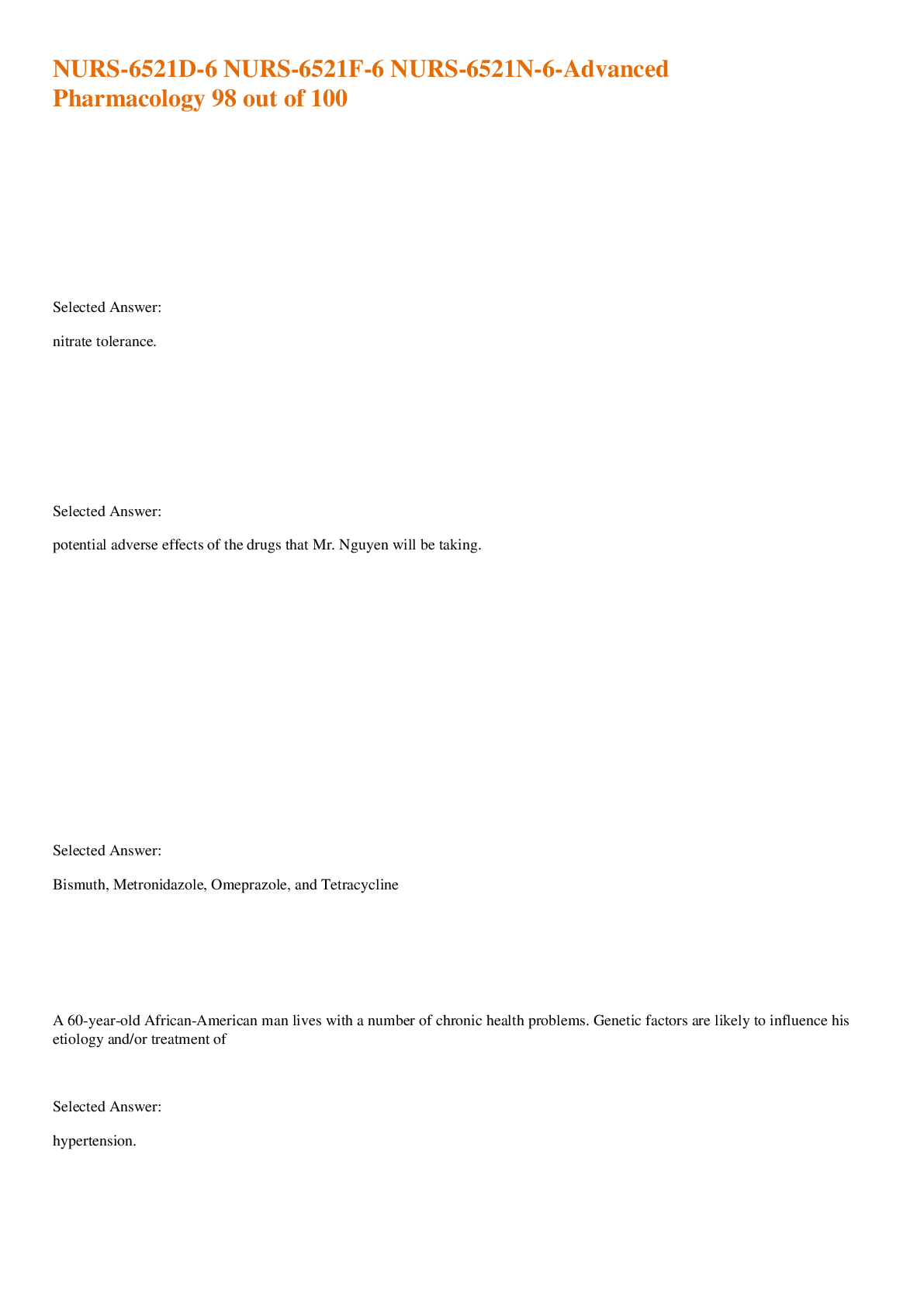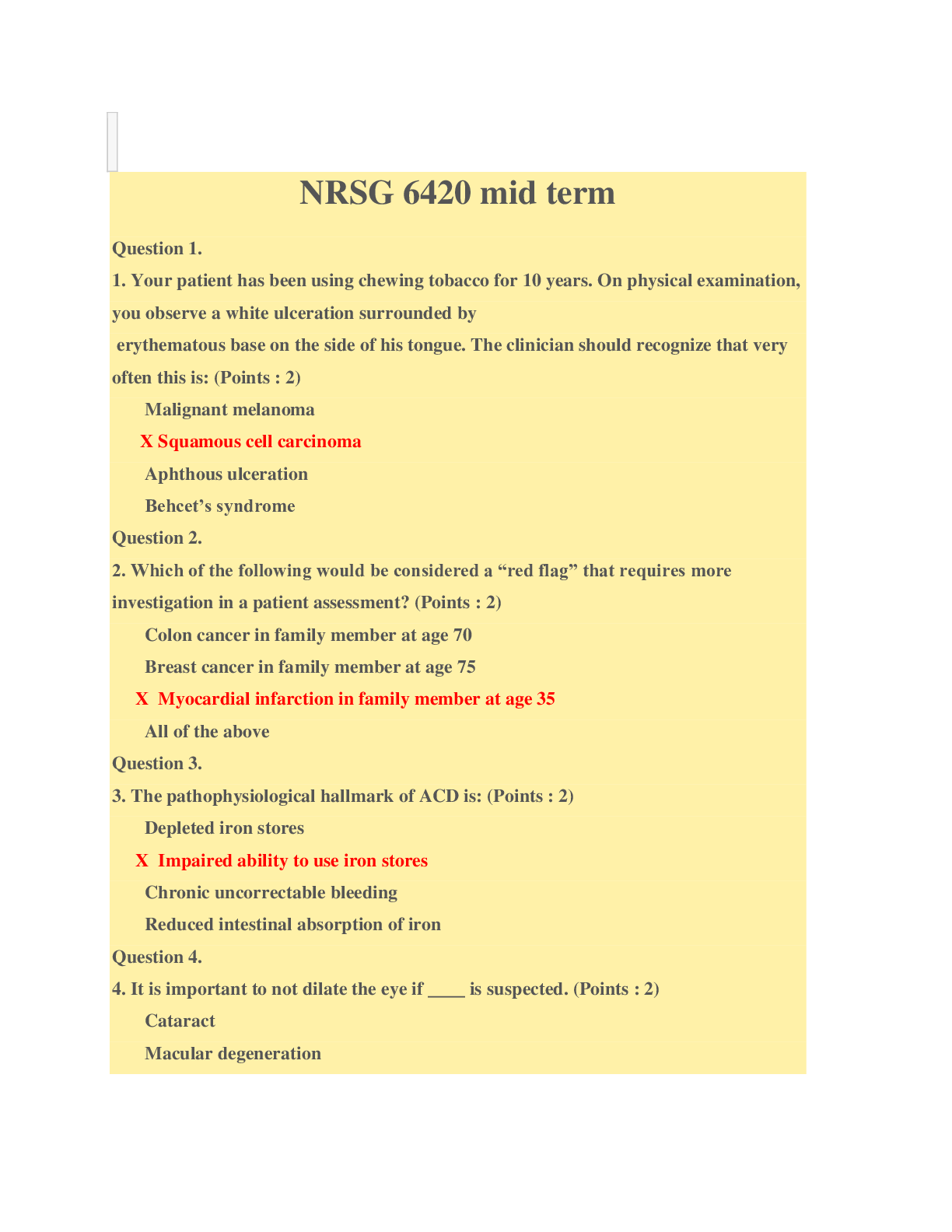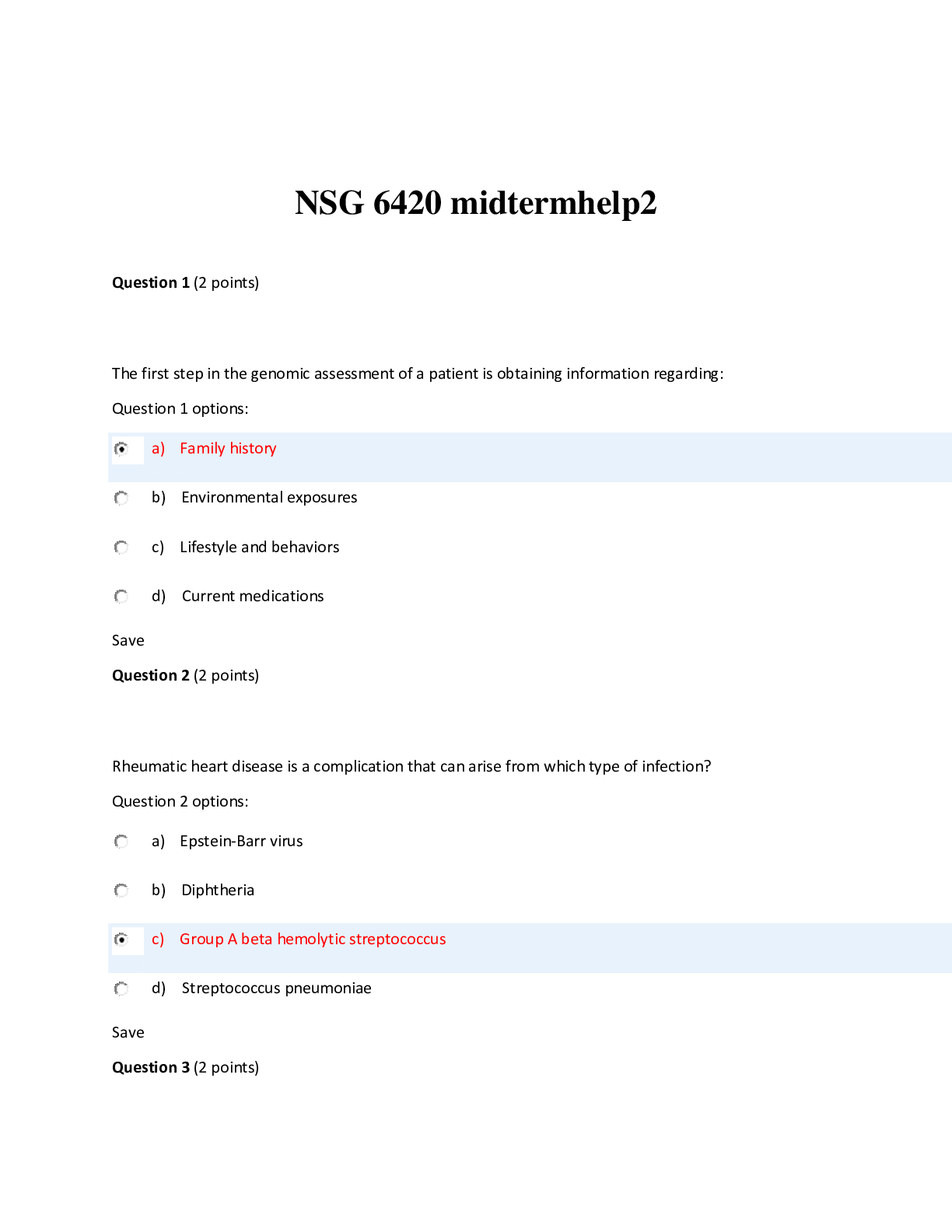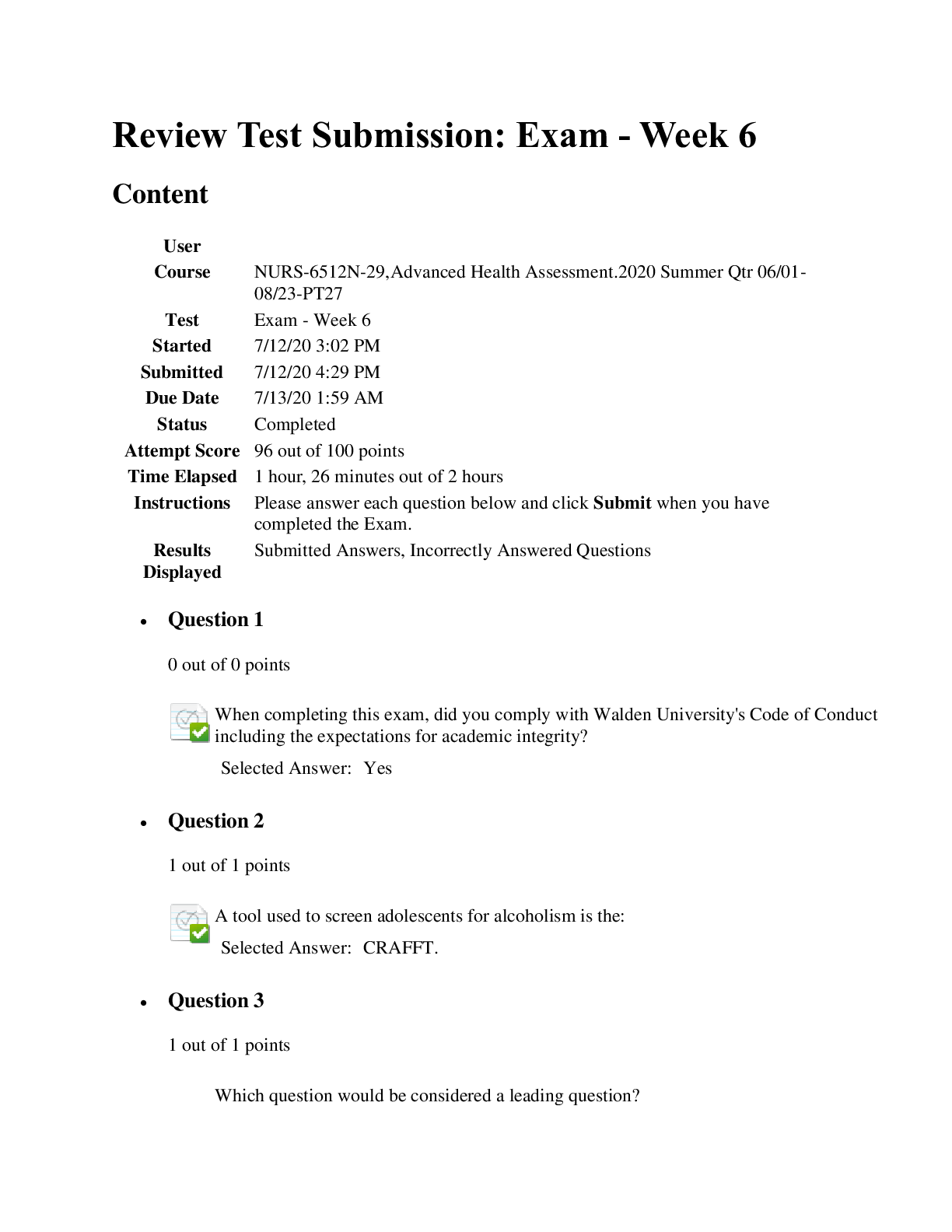*NURSING > EXAM > NSG 6001 Study Questions for Mid Term Exam Advanced Practice Nursing I | NSG6001 Study Questions - G (All)
NSG 6001 Study Questions for Mid Term Exam Advanced Practice Nursing I | NSG6001 Study Questions - Guide for Week 3 Quiz Question And Answers.
Document Content and Description Below
NSG 6001 Study Questions for Mid Term Exam Advanced Practice Nursing I Guide for Week 3 Quiz – Study the following: 1) Women and assessing by procedures for CAD - ACC guidelines do not recommend str... ess tests for asymptomatic patients unless women are 55 years> , is sedentary & wishes to begin exercising aggressively; For women who are symptomatic but who have a normal resting ECG recording, good exercise tolerance, and no coronary risk factors, an exercise stress test is appropriate; diagnostic imaging is not recommended for low-risk women who are asymptomatic; For women who are symptomatic and have known CAD, an abnormal resting ECG recording, questionable exercise tolerance, or coronary risk factors such as diabetes or peripheral arterial disease, stress test imaging is recommended. The burden of coronary artery disease (CAD) in women is significant. In spite of increasing uses of noninvasive testing, coronary angiography remains the gold standard in the diagnosis and assessment of CAD. Since gender differences exist in the clinical presentation of CAD and in the sensitivity and specificity of noninvasive testing, coronary angiography remains an invaluable tool in providing diagnostic and prognostic information in women. 2) Changes that occur in an ECG that demonstrate ischemia late in the ischemic cascade - Typical ECG changes of ischemia result, although the ST-segment and T-wave changes that are central to demonstration of ischemia occur relatively late in the ischemic cascade; The hypoperfusion produces first diastolic, and then systolic dysfunction, with characteristic signs and symptoms of chest pain; Various imaging modalities that can be used as adjuncts to the graded exercise test can be viewed in the context of the ischemic cascade. 3) Understand the terms: Specificity and Sensitivity and an exercise echocardiography 2DE - Current data suggest that adjunctive echocardiographic imaging enhances the sensitivity and specificity of CAD detection to an extent comparable to that provided by nuclear techniques. Another study found the sensitivity of dobutamine stress 2DE to be comparable to that of dobutamine single-photon emission CT (85% versus 80%, respectively). The specificity of the two techniques was also comparable (82% versus 74%, respectively), as were the predictive values. Sensitivity – percentage of people with disease who test positive Spcificity – percentage of people without disease who test negative 4) What part of Medicare covers inpatient hospital services - Part A – paid through federal payroll taxes – Covers inpatient hospital services as well as some post-hospital nursing care & home health care 5) Stress-induced ischemia – ETT increase workload incrementally to induce ischemia or until a predetermined workload is reached Recent evidence, particularly from the Women's Ischemia Syndrome Evaluation study, a multicenter study sponsored by the National Heart, Lung, and Blood Institute, has demonstrated that many women without obstructive CAD continue to have symptoms and a poor quality of life. Many of these women have evidence of stress-induced ischemia, which is likely to be related to endothelial dysfunction of the microvasculature. 6) How does an echocardiogram enhance a standard ETT - The ETT is typically adequate as a means of observing disease progression for purposes of prognostication and timing of revascularization procedures. However, with respect to the delineation of damaged myocardial regions and residual myocardial viability in zones of prior injury, it has become clear that adjunctive radiopharmaceutical or cardiac ultrasound imaging substantially improves test sensitivity and specificity. The 2DE (Two-Dimensional Exercise Echocardiography) evidence for ischemia includes an abnormal left ventricular ejection fraction (LVEF) response to exercise or the development of regional wall motion abnormalities. The exercise is performed with a bicycle or treadmill, and dobutamine is the most common pharmacologic agent used simultaneously with the echocardiography imaging. The image quality may be enhanced by the injection of echogenic microbubbles. 7) Term used for the encouragement of patients to be active in their own healthcare - Patients are empowered to research their disorders, to ask questions, and to dialogue with others about their symptoms and possible treatments. This empowerment has engaged patients in their own health, enabling a partnership with their primary care provider. 8) Women and symptoms of CAD - Women have different patterns of CAD and different responses to cardiac testing. This disorder is not diagnosed expeditiously; Women are more likely to have non-obstructive or single-vessel disease which decreased diagnostic accuracy of stress testing; Single-photon emission CT imaging is technically limited in women because breast tissue and smaller coronary artery size; Many of these women have evidence of stress-induced ischemia, which is likely to be related to endothelial dysfunction of the microvasculature; if the woman has diabetes and peripheral arterial disease are CAD risk equivalents 9) A negative ETT - when 85% of age predicted maximum heart without inducible ischemic – Maximum heart rate = 220-age 10) Physiological changes that occur during a routine ETT - The primary goal of the ETT is to increase workload incrementally to induce ischemia or until a predetermined workload is reached. 11) The agent is most commonly used to administer an ETT - bicycle & treadmill 12) The meaning of an ST segment elevation during an exercise stress test - for L. coronary artery or reflects acute thrombotic coronary stenosis occlusion; ST elevated after MI – terminate exercise 13) The meaning of left ventricle wall thinning and there is some hyperkinesis of the ventricular wall during an echocardiogram exercise test - ( exercise echocardiogram) 14) Criteria of a positive stress test - patient is asked to perform incremental exercise that result in positive chronotropic (rate) and inatropic (strength of contraction) to increase myocardial oxygen demand; The normal hemodynamic response to these stimuli is an increase in absolute coronary blood flow; However, this ability is reduced in the presence of CAD, which leads to an imbalance between oxygen supply and demand, resulting in myocardial ischemia and ischemic changes in the electrocardiogram. - - - - - - - - - - - - - - - - - - - - - - - - - - - For women who are symptomatic but who have a normal resting ECG recording, good exercise tolerance, and no coronary risk factors, an exercise stress test is appropriate; diagnostic imaging is not recommended for low-risk women who are asymptomatic.15 For women who are symptomatic and have known CAD, an abnormal resting ECG recording, questionable exercise tolerance, or coronary risk factors (e.g., diabetes, peripheral arterial disease), stress test imaging is recommended. Cardiac ultrasound and MPI are of comparable usefulness in detecting CAD. The ACC/AHA Task Force on Practice Guidelines suggested that exercise MPI or exercise echocardiography may be used as the initial test for diagnosis in patients with chronic stable angina who are able to tolerate exercise Three-dimensional (3D) echocardiographic techniques are currently available that use magnetic resonance imaging (MRI) and computer-assisted 3D acquisition systems for 2DE. Three-dimensional technology is recently available and provides a unique view of structure and function within the heart. Doppler flow studies are used to localize and to quantify obstructions in the cardiovascular system. Primarily, the addition of a Doppler flow study to echocardiography enhances the ability to evaluate prosthetic valve function. Approximately 20% of ischemic strokes result from carotid artery disease,6 which is defined as atherosclerotic narrowing of the extracranial arteries, most often at the bifurcation of the carotid artery, with involvement of the proximal internal carotid artery. Stroke is the third leading cause of death and the leading cause of long-term disability in the United States.1 Each year, more than 795,000 people suffer a stroke Before initiation of an exercise program, most patients should undergo some form of exercise testing to determine the appropriateness of an exercise program. Exercise testing will evaluate for ischemia or arrhythmias in heart failure patients. Ischemic changes on ECG during ETT is highly predictive of CAD. What is another important strong predictor of CAD that you might see during an ETT? Student Answer: Exercise-induced hypertension Exercise-induced hypotension (Another important strong predictor of CAD that you might see during an ETT is exercise-induced hypotension. ) Slow heart rate Rapid heart rate You are counseling a patient diagnosed with stress-induced ischemia. You base your discussion on your knowledge that stress-induced ischemia is thought to be caused by what phenomena? Student Answer: Heart muscle dysfunction Too many carbonated drinks Diet and exercise Endothelial dysfunction of the microvascular (You base your discussion on your knowledge that stress-induced ischemia is thought to be caused by endothelial dysfunction of the microvascular.) Your patient underwent an exercise stress test for CAD. There is significant elevation of the ST-segment. What do you need to know about these changes to manage your patient’s care? Student Answer: These changes have minimal predictive value for CAD (Significant elevation of the ST-segment has minimal predictive value for CAD. ) These changes predict dire outcomes This patient needs to see someone more experienced in treatment of CAD These changes are predictive of myocardial infarction Your patient has a maximum age-predicted heart rate of 180. During the exercise, he reaches a heart rate of 140 and then states he can no longer exercise. You see no evidence of ischemia on the ECG. This would be diagnostic for what condition? Student Answer: Diagnostic for impending Myocardial Infarction Predictive of no CAD Diagnostic of laziness Has no diagnostic value to rule out CAD (This scenario has no diagnostic value to rule out CAD.) [Show More]
Last updated: 2 years ago
Preview 1 out of 12 pages
.png)
Buy this document to get the full access instantly
Instant Download Access after purchase
Buy NowInstant download
We Accept:

Reviews( 0 )
$16.50
Can't find what you want? Try our AI powered Search
Document information
Connected school, study & course
About the document
Uploaded On
Sep 23, 2020
Number of pages
12
Written in
Additional information
This document has been written for:
Uploaded
Sep 23, 2020
Downloads
0
Views
106

.png)

















.png)
 – Strayer University.png)


 _ South University Savannah.png)

